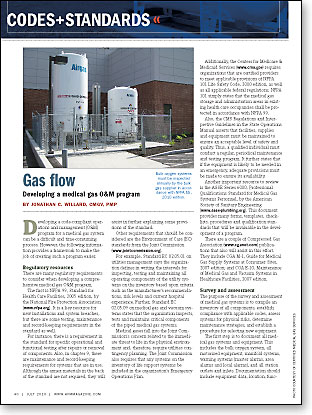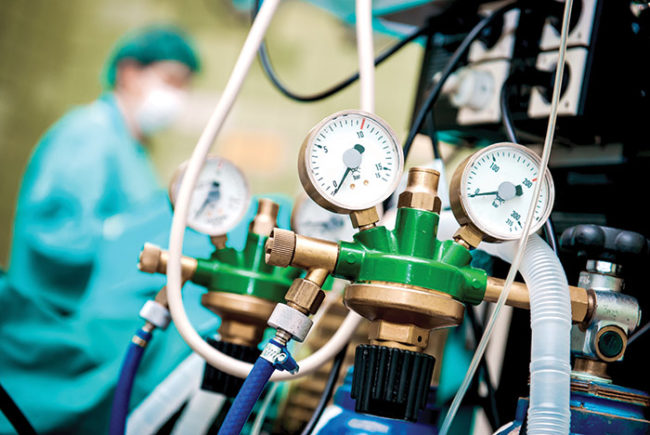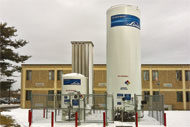 Developing a code-compliant operations and management (O&M) program for a medical gas system can be a difficult and time-consuming process. However, the following information provides a framework to make the job of creating such a program easier.
Developing a code-compliant operations and management (O&M) program for a medical gas system can be a difficult and time-consuming process. However, the following information provides a framework to make the job of creating such a program easier.
Regulatory resources
There are many regulatory requirements to consider when developing a comprehensive medical gas O&M program.
The first is NFPA 99, Standard for Health Care Facilities, 2005 edition, by the National Fire Protection Association (www.nfpa.or). It is a key resource for new installations and system breaches, but there are some testing, maintenance and record-keeping requirements in the standard as well.
For instance, there is a requirement in the standard for specific operational and functional testing after repairs or removal of components. Also, in chapter 9, there are maintenance and record-keeping requirements for systems that are in use. Although the annex materials in the back of the standard are not required, they will assist in further explaining some provisions of the standard.
Other requirements that should be considered are the Environment of Care (EC) standards from the Joint Commission (www.jointcommission.org).
For example, Standard EC 02.05.01 on utilities management says the organization defines in writing the intervals for inspecting, testing and maintaining all operating components of the utility systems on the inventory based upon criteria such as the manufacturer's recommendations, risk levels and current hospital experience. Further, Standard EC 02.05.09 on medical gas and vacuum systems states that the organization inspects, tests and maintains critical components of the piped medical gas systems.
Medical gases fall into the Joint Commission's concern related to the immediate threat to life in the physical environment and, therefore, require utilities contingency planning. The Joint Commission also requires that any systems on the inventory of life support systems be included in the organization's Emergency Operations Plan.
Additionally, the Centers for Medicare & Medicaid Services (www.cms.gov) requires organizations that are certified providers to meet applicable provisions of NFPA 101 Life Safety Code, 2000 edition, as well as all applicable federal regulations. NFPA 101 simply states that the medical gas storage and administration areas in existing health care occupancies shall be protected in accordance with NFPA 99.
Also, the CMS Regulations and Interpretive Guidelines in the State Operations Manual asserts that facilities, supplies and equipment must be maintained to ensure an acceptable level of safety and quality. Thus, a qualified individual must conduct a regular, periodical maintenance and testing program. It further states that if the equipment is likely to be needed in an emergency, adequate provisions must be made to ensure its availability.
Another important resource to review is the ASSE Series 6000, Professional Qualifications Standard for Medical Gas Systems Personnel, by the American Society of Sanitary Engineering (www.asse-plumbing.org). This document provides many forms, templates, checklists, procedures and qualification standards that will be invaluable in the development of a program.
There are a couple of Compressed Gas Association (www.cganet.com) publications that also will assist in this effort. They include CGA M-1, Guide for Medical Gas Supply Systems at Consumer Sites, 2007 edition; and CGA E-10, Maintenance of Medical Gas and Vacuum Systems in Healthcare Facilities, 2007 edition.
Survey and assessment
The purpose of the survey and assessment of medical gas systems is to compile an inventory of all components, establish compliance with applicable codes, assess systems for physical risks, determine maintenance strategies, and establish a procedure for selecting new equipment.
The first step is to document all medical gas systems and equipment. This includes the bulk oxygen system, all motorized equipment, manifold systems, warning systems (master alarms, area alarms and local alarms), and all station outlets and inlets. Documentation should include equipment data, location, function, areas served and approximate life expectancy, to assist with capital planning. Also, all manufacturers' operation and maintenance manuals should be included.
After the equipment has been inventoried, the systems should be assessed for code compliance. Facilities professionals should consider gaining assistance from a subject matter expert for this task. Once all the code deficiencies have been identified, they should be categorized based on (1) immediate threat to patient safety, (2) possible threat to patient safety or (3) no threat to patient safety.
If there is an immediate threat to patient safety, it should be corrected immediately. If the deficiency is classified as a possible threat to patient safety, a risk assessment should be conducted to determine whether it is, in fact, a threat to patient safety. This may require a review by the authority having jurisdiction (AHJ) for a determination. If there is no threat to patient safety, it becomes an organizational decision whether to correct the deficiency. It also may be considered for a capital improvement project.
After the code compliance review, the systems should be evaluated for physical risks from use of the equipment.
The first step is to develop a risk-ranking method to be used for the assessment. If the organization already has a method, it is fine to use it. As a result of this assessment, it should be determined whether the equipment is life supporting. If any of the systems are determined to be life supporting, they should be given additional consideration for inspection and testing. This process will assist in the development of the organization's emergency management plan by establishing which systems are required to have a contingency plan for emergencies.
Selection of a maintenance strategy is at the discretion of the organization. There are many strategies to consider. Interval-based, predictive, reliability-centered, metered and run-to-fail are the most common practiced in health care. To determine the most appropriate strategies, facilities professionals must first understand how the equipment operates, how it might fail and the clinical impact of different failure scenarios. Not every strategy is appropriate for every piece of equipment. For example, run-to-fail may be a good strategy for the station outlets, but is not an appropriate strategy for vacuum pumps.
The selection of new equipment should be an established and documented process. The EC states that the organization must consult with equipment manufacturers prior to acquisition, must involve both the individuals who operate the equipment and those who service it and must review how the equipment will interface with other existing equipment. Also, the organization should evaluate maintenance requirements and availability of repair parts and repair services.
Scheduling activities
Once the hard work of determining the location and current condition of the medical gas equipment and how it will be maintained has been accomplished, it is time to establish the intervals and schedules of the specific activities. The identification of these activities should be based on regulatory requirements, manufacturer's recommendations, accepted industry practices and the organization's past experiences.
During review of national regulatory requirements, facilities professionals should be sure to consider any applicable local code requirements as well. When establishing intervals, the manufacturer's recommendations are always a good place to start. These recommendations tend to be based on the manufacturer's experiences and quality testing conducted to ensure equipment longevity.
The bottom line for establishing schedules is that the organization must follow a documented procedure. This can be as simple as conducting an annual inspection of the medical gas systems and maintaining the equipment per the manufacturer's recommendations.
The required inspection and testing schedules can be found in NFPA 99, the EC and the CMS standards and generally consist of annual inspection and testing of the warning systems (master alarms, area alarms and local alarms), source supply systems, station outlets and inlets, articulating booms and manufactured assemblies such as flexible connectors, and bulk oxygen systems. The bulk gas supplier must inspect the bulk oxygen system at least annually according to the requirements of NFPA 55, 2010 edition.
However, from a safety and liability standpoint, this minimum requirement may not be the best policy. Many of the recommended activities are designed to ensure that systems are performing at optimal levels and that the safe operation of the systems is reviewed on a continual basis. These recommended schedules can be found in the important resource documents discussed earlier. For example, it is recommended in the ASSE 6000 document that some components be inspected as frequently as daily.
Recommended daily inspections include confirming mainline pressure for each system is within acceptable limits of plus or minus 5 percent, inspecting the moisture removal systems on the medical air and vacuum systems, and inspecting the bulk oxygen system tank contents. There are also recommended inspections and testing activities to be conducted on a monthly, quarterly, semiannual and annual basis (other than items identified as required above).
Many of the activities identified in the recommended schedules only take a few minutes to complete, but the value of these inspections is considerable from a maintenance, troubleshooting and safety perspective.
Developing procedures
After identifying the frequencies of all the maintenance, inspection and testing activities, the health care organization should develop and document the procedures that will be followed.
The general work requirements should include procedures for ensuring tools, parts and equipment are kept clean and free from contamination (dirt, grease or oil). The health care organization's safety program should be incorporated into this section. The section also should include guidelines for employee and vendor orientation and equipment overview prior to commencement of any work.
The guidelines should address the review of physical properties and the distinct hazards associated with the equipment as well as procedures to prevent cross connection of systems.
Procedures for the inspection and testing of the medical gas systems should be documented. If in-house personnel conduct the tasks, the organization is responsible for documentation. This needs to be a step-by-step, cookbook-style process.
If vendors are utilized, they are responsible for documentation. However, in such cases, the organization may want to have a statement of compliance for vendors. It might read: "All maintenance, inspections and testing on the medical gas systems shall be performed per the manufacturer's recommendations and in accordance with NFPA 99, 2005 edition, and industry-accepted standard operating procedures. If adherence to these standards is not possible, substitute procedures shall be submitted to the organization for review prior to the commencement of any work on the medical gas systems." Procedures for system shutdowns should also be developed and documented.
Emergency operations planning should be conducted for any equipment that has been classified as life supporting. The four phases of an emergency (mitigation, preparedness, response and recovery) should be addressed. Systems to consider for this contingency planning include the oxygen, medical air and vacuum systems.
All maintenance, inspection and testing results should be documented and kept on file. Any planned shutdown or system breaches should be documented. The third-party verifier's report will suffice for documentation. These records should be available for AHJs upon request.
Qualifications and training
Once procedures have been developed, it is time to determine whether health facility personnel or an outside vendor will perform the specific tasks. Either way, the health care organization will want to determine the necessary qualifications to perform these tasks and make additional training available.
Maintenance, inspections and testing should be conducted by individuals technically competent and experienced with medical gas systems. Some qualifications the organization may consider include the ASSE 6040 maintenance personnel certification or other documented programs for equipment training, such as those offered by manufacturers or various online courses. For inspection and testing activities, organizations may consider the ASSE 6020 inspector certification, ASSE 6030 verifier certification and the Medical Gas Professional Healthcare Organization (www.mgpho.org) Credentialed Medical Gas Verifier (CMGV™) certification.
The EC standards state that the organization must provide adequate training of personnel, must ensure competency of individuals for the operations they perform and must provide continuing education to minimize physical risks to patients and personnel.
Furthermore, the Food and Drug Administration (FDA) requires that each person handling a drug product has the education, training and experience necessary to perform the assigned tasks.
Because medical gases are considered FDA-regulated drugs, personnel training and continuing education are a must. Any training and continuing education should be documented in the employee's file.
Ensuring safety
Patients rely on health care organizations to ensure that their safety and well-being are continuously protected.
Developing a comprehensive medical gas systems operations and management program is the best way to ensure these systems remain safe and reliable.
Jonathan C. Willard, CMGV, PMP, is the president of Certified Medical Gas Services, New Boston, N.H. He is a principal member of the NFPA technical committee responsible for NFPA 99 Health Care Facilities—Medical Gas and Vacuum Systems section. He can be reached at jwillard@certifiedmedgas.com. This tutorial provides a general description of regulatory requirements and does not constitute legal advice.
| Sidebar - Sample med gas testing procedure |
| A typical medical gas system has a wide variety of elements that must be tested to ensure patient safety, functional worthiness and code compliance. The following example shows the procedure for testing automatic control of the medical gas manifold system as it changes from the primary use side of the manifold to the secondary use side:
Many industry standard testing and inspection procedures can be found in the annex of the American Society of Sanitary Engineering's ASSE 6000 Series, Professional Qualifications Standard for Medical Gas Systems Personnel, which can be purchased at www.asse-plumbing.org. Another source for testing and inspection policies and procedures is the Compressed Gas Association documents mentioned in the article (CGA M-1 and CGA E-10). These can be purchased at www.cganet.com. |





